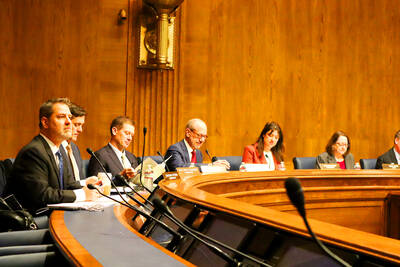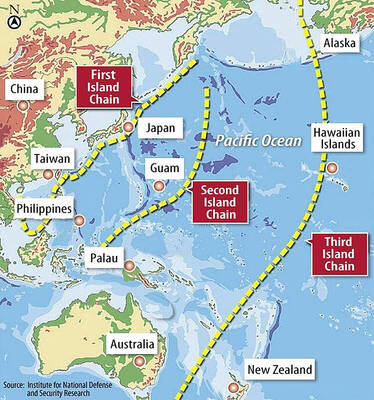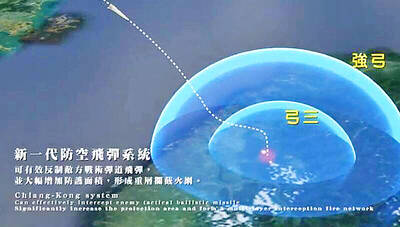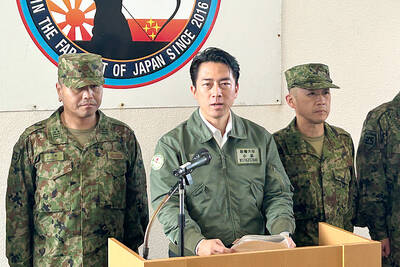Representatives of the self-help organization of Siaolin Village (小林), Kaohsiung County, that was wiped out by Typhoon Morakot in August, leaving nearly 500 people buried by massive landslides, yesterday called for a debate with the government over the causes of the disaster.
The demand came after the release of an official report by the Public Construction Commission (PCC) on Monday that blamed the tragedy on record rainfall and not a water diversion project many typhoon survivors considered the main reason.
“We have substantial evidence to challenge the findings and do not fear a debate. The report was fraught with errors. If our request is denied, we will see them in court,” Lu Tai-ying (魯台營) told the Taipei Times by telephone.
Lu said that while the report claimed the main cause of the mudslide was the 1,856mm of rain that fell within 72 hours in Siaolin, the village was flattened 48 hours after the rain began.
“When the mudslide occurred, the accumulated rainfall was between 1,400mm and 1,500mm. If the report was right about the critical value of precipitation, which it said was 1,700mm, rainfall should be one of the causes, but not the main cause,” Lu said.
Lu also questioned the adequacy of the rationale used to rule out the possibility of the trans-basin water diversion tunnel project, designed to channel water from the Laonong River (荖濃溪) to the Zengwun Reservoir (曾文水庫), as the prime cause of the mudslide.
At a press conference held yesterday morning to present the report, Shannon Lee (李咸亨), spokesman of the team in charge of the report, likened the impact on the local geology caused by the tunnel’s drill and blast construction method to hits by a mosquito.
”I really wanted to find evidence that supports the claim [that the tunnel project was behind the mudslide], but I couldn’t,” Lee said.
Lee said the tremors caused by the construction of the tunnel did not exceed the threshold that would lead to the disaster.
He said the conclusion was partly drawn from the fact that the non-conformance rate of tremors caused by the construction work during the period between 2006 and 2008 was less than the normal environment background level recorded between 2004 and 2006, according to the data kept by the Environment Protection Administration.
The construction began on Dec. 20, 2006.
Lee said the report’s conclusion was also based on the fact that the amount of explosives used to blast the tunnel was insufficient to have caused tremors large enough to lead to disaster.
The largest amount of explosives used at any one time was 182kg, less than the tremor caused by the 2006 Hengchun Earthquake, the equivalent of 475 million kilograms of explosives.
“I was also challenged by people who said that even small tremors could cause disasters when they are repeated,” Lee said.
“My answer was: ‘The tremor caused by the drill-and-blast method was like the energy released by a firework. Even if a firework is ignited 100 times, the energy still cannot be compared to the energy that is released by an earthquake,’” Lee said.
“If a person is hit by a mosquito several hundred times, it can’t be compared to being run over by a tank,” he said.
Lu, however, said that the report did not give direct evidence to prove that the impact of the water diversion project was negligible.
“What basis do they have to claim that the project was unrelated? The [stated-owned] Central Geological Survey recently found that the tunnel was constructed across a fault called the Nei-ying Fault [內英斷層]. The report didn’t even mention that,” Lu said.
Given the fact that the country had never completed a thorough survey into its geology and had a very limited understanding, “why did they jump to such a conclusion?” Lu said.
Later yesterday, Lee said by telephone that while he agreed with Lu about the “lack of a detailed understanding of the sensitivity of geology,” the conclusions reached by his team remained valid.
“In theory, it is possible that a tunnel construction project could cause a mudslide ... but in this case, it was an extremely low likelihood,” Lee said.
Lee said he regretted that a plan, suggested by Wulf Schubert, an Austrian expert, to use the drill-and-blast method to construct an experimental tunnel at 16 sites to test the impact of such a project on the environment was called off due to opposition by residents.
PCC chairman Frank Fan (范良銹) said the commission would refer the report to the Executive Yuan, which will decide whether to resume the suspended water diversion project.
The research team was formed by members of the Chinese Institute of Civil and Hydraulic Engineering (CICHE) and led by Chen Ching-chun (陳清泉), a professor at the Department of Civil Engineering at National Taiwan University.

LIMITS: While China increases military pressure on Taiwan and expands its use of cognitive warfare, it is unwilling to target tech supply chains, the report said US and Taiwan military officials have warned that the Chinese People’s Liberation Army (PLA) could implement a blockade within “a matter of hours” and need only “minimal conversion time” prior to an attack on Taiwan, a report released on Tuesday by the US Senate’s China Economic and Security Review Commission said. “While there is no indication that China is planning an imminent attack, the United States and its allies and partners can no longer assume that a Taiwan contingency is a distant possibility for which they would have ample time to prepare,” it said. The commission made the comments in its annual

DETERMINATION: Beijing’s actions toward Tokyo have drawn international attention, but would likely bolster regional coordination and defense networks, the report said Japanese Prime Minister Sanae Takaichi’s administration is likely to prioritize security reforms and deterrence in the face of recent “hybrid” threats from China, the National Security Bureau (NSB) said. The bureau made the assessment in a written report to the Legislative Yuan ahead of an oral report and questions-and-answers session at the legislature’s Foreign Affairs and National Defense Committee tomorrow. The key points of Japan’s security reforms would be to reinforce security cooperation with the US, including enhancing defense deployment in the first island chain, pushing forward the integrated command and operations of the Japan Self-Defense Forces and US Forces Japan, as

INTERCEPTION: The 30km test ceiling shows that the CSIST is capable of producing missiles that could stop inbound missiles as they re-enter the atmosphere Recent missile tests by the Chungshan Institute of Science and Technology (CSIST) show that Taiwan’s missiles are capable of intercepting ballistic missiles as they re-enter the atmosphere and pose a significant deterrent to Chinese missile threats, former Hsiung Feng III missile development project chief engineer Chang Cheng (張誠) said yesterday. The military-affiliated institute has been conducting missile tests, believed to be related to Project Chiang Kung (強弓) at Pingtung County’s Jiupeng Military Base, with many tests deviating from past practices of setting restriction zones at “unlimited” and instead clearly stating a 30.48km range, Chang said. “Unlimited” restrictions zones for missile tests is

IN THE NATIONAL INTEREST: Deputy Minister of Foreign Affairs Francois Wu said the strengthening of military facilities would help to maintain security in the Taiwan Strait Japanese Minister of Defense Shinjiro Koizumi, visiting a military base close to Taiwan, said plans to deploy missiles to the post would move forward as tensions smolder between Tokyo and Beijing. “The deployment can help lower the chance of an armed attack on our country,” Koizumi told reporters on Sunday as he wrapped up his first trip to the base on the southern Japanese island of Yonaguni. “The view that it will heighten regional tensions is not accurate.” Former Japanese minister of defense Gen Nakatani in January said that Tokyo wanted to base Type 03 Chu-SAM missiles on Yonaguni, but little progress